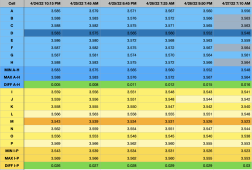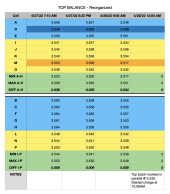Let me back up and reiterate that we want to match based on capacity; putting the lowest capacity cells in one battery and the highest capacity cells in the other.
Other than capacity testing all of your cells individually (which i have never done nor do i have a capacity tester), the next best is to watch which cells run away at charge and discharge extremes.
Batch #1:
Earlier I mentioned "positions 3,4,8 and possibly 6 that are different (lower capacity)."
What cell labels are those now? Those are the lower capacity ones in your first batch.
I have been working on a theory as others have also suggested, that "the lower capacity cells self-discharge faster". Is this reflected in your table above? (i cannot tell where cells 3,4,8 and 6 fall into your new labels). Are they cells C,D,F and H?
From your table it looks like B,C,F and H are the fasted discharge cells.
Please confirm labels and how they relate to original numbers.
Batch #2
Lets try to match those with the lower capacity cells in your second batch (presumable I - P labeled above).
The only data we have are the surface charge dissipations over the periods in your table, correct?





